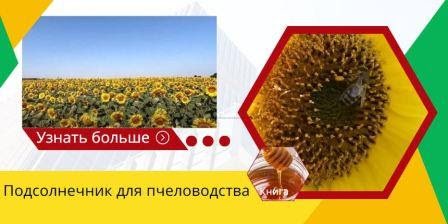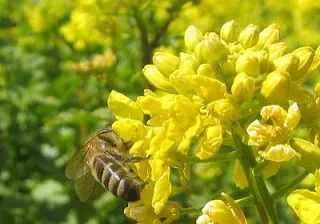Mustard white as a honey plant
Mustard as a honey plant for beekeeping is a very valuable honey plant. White mustard honey plant, which allows you to significantly expand the honey base by sowing mustard with other crops. White mustard is a honey plant that can fill the free period before the main honey collection and will help the beekeeper to build up a bee for the main honey collection and prevent the apiary from being buried. Mustard as a honey plant will help to improve the health of bees before honey collection or before wintering. Mustard is a honey plant from which bees collect a lot of pollen from pollen.
Content
- Description of white mustard as a honey plant
- Mustard white honey productivity in different climatic conditions
- Mustard as honey plant for beekeeping in autumn
- White mustard as honey plant and pollen plant
- White mustard honey
- White mustard as a honey plant in mixed crops
- Mustard as a honey plant for beekeeping in questions and answers
...
.
...
Description of white mustard as a honey plant
White mustard is an annual honey plant. (Latin name Sinapis alba L.) - with a deep root system and a very large green mass. White mustard is resistant to frost. The root secretions of white mustard contribute to the dissolution of various compounds found in the soil in a sparingly soluble form.
The mustard
stalk is branched in height, reaches 60-
The
flowering of white mustard occurs in June-July, the flowering time of white
mustard is 20-35 days.
Flowering
mustard white honey plant is as follows. From the moment the yellow petals
bloom to their drying, 3 days pass, and 4 days pass before falling off. Flowers
open between 6 and 7 o'clock. A little time later, mustard pollen spills out of
the anthers and by 8 o’clock it already accumulates outside in sufficient
volume. On the second day after the start of flowering, individual flowers of
white mustard, which closed in the evening, open again at about 9 o'clock in
the morning, and some still half-open on the third day. In each inflorescence,
white mustard blooms from the bottom up. White mustard flowers attract bees
with their color, size, aroma.
Mustard white honey productivity in different climatic conditions
Mustard
white honey productivity. The honey productivity of mustard is quite high. The
sugar productivity of one flower of white mustard during the day is 0.3-0.5 mg,
the honey productivity of white mustard varies from 30 to
The honey
productivity of white mustard depends on environmental, weather, abiotic and
other factors.
In the
weather conditions of Mari El, white mustard blooms 39 days after sowing. The
flowering period of one white mustard flower is 3 days. The average sugar
content in one flower varies within 0.29 mg. The honey productivity of one
plant of white mustard for the entire flowering period is 86.5 mg, and the
honey productivity of white mustard with continuous growth on one hectare is
White
mustard honey plant releases nectar unevenly during the day, little nectar is
released in the morning and evening, most white mustard releases nectar during
the day from 12 to 17 hours. The optimum temperature for white mustard flowers
to produce nectar is 20-29 degrees Celsius.
For
example, the sowing time plays a significant role in the allocation of white
mustard flowers of nectar. So, when sowing white mustard on May 29, honey
productivity is
When to
plant mustard for bees in Mari El? It is recommended to sow white mustard as a
honey plant in the middle or end of May.
In the
middle lane for beekeeping, white mustard can be sown in 3 terms.
The first
sowing of white mustard is carried out in mid-May, the second sowing of white
mustard for beekeeping at the end of May, the third in the first ten days of
June, this allows you to significantly increase the duration of honey
collection from white mustard.
How much
honey can be obtained from
When to
plant bee mustard? In the conditions of the Oryol region, it is quite possible
to create a honey-bearing conveyor from white mustard, sowing it every 10 days
from May 1 to August 1. With such a conveyor, the flowering period of white
mustard can be increased up to three and a half months.
How and
when to sow mustard for bees in spring? In the conditions of the Oryol region,
the most interesting is the sowing of white mustard for beekeeping in the early
stages - in the first decade of May, in a wide-row way, mustard for beekeeping
with a seeding rate of
Under the
natural conditions of the
In crops of
white mustard in the
Mustard
white honey productivity in Primorsky Krai is 30-
With such
an excellent honey productivity of white mustard, anyway, some beekeepers have
a question - mustard honey plant or not, mustard honey plant or not? It should
be noted that bees do not always collect nectar from mustard. If strong honey
plants bloom nearby, the bees will switch to them. Also, cold night weather
does not contribute to the honey collection from mustard, as well as severe
drought. But the pollen from the mustard of the white bee is always carried to
the hive. So to the question of mustard honey plant or not, the answer is
simple - mustard honey plant.
Mustard as honey plant for beekeeping in autumn
How and
when to sow mustard for bees in the second half of the season? You can also sow
mustard as a honey plant as a stubble crop after harvesting cereals. In this
case, white mustard is sown in the first half of August, in an ordinary way,
mustard for beekeeping, the seeding rate is
Mustard white like honey plant and pollen plant
White
mustard for bees releases a lot of pollen. During mustard flowering, white bees
bring large amounts of pollen to the hive. Yellow mustard pollen. One hectare
of continuous mustard herbage is capable of producing an average of 260-
In the
conditions of the Oryol region, the largest amount of pollen in the flowers of
white mustard is formed during the period of mass flowering. The pollen
productivity of white mustard varies considerably from year to year. Pollen
production can be from
white mustard honey
Mustard
white as a honey plant is a very good plant. Mustard honey is white, pale
yellow in color, after crystallization it has a cream color and has a spicy
taste and aroma. It crystallizes quite slowly, white mustard honey is very
soft. Like any cruciferous honey, bees should not leave it in the winter.
Mustard white as a honey plant in mixed crops
Mustard
white as a honey plant is an excellent plant for creating a honey conveyor. It
is possible to sow mustard as a honey plant not only in clean crops, but also
in joint crops with other crops, such as common vetch, sowing rank, sowing
peas, where mustard attracts bees, supports the shoots of the accompanying plant.
When sowing
white mustard with common vetch, the honey productivity of crops is
When sowing
white mustard with common pea or sowing peas, mustard attracts bees to such
crops and provides the opportunity for bees to collect 40-
Mustard as a honey plant for beekeeping in questions and answers
Many
farmers and beekeepers have questions about mustard and bees - do bees
pollinate mustard? The answer is yes bees pollinate mustard. White seed yield mustard
is equal to 8-10 centners per
The
question is how many days after sowing phacelia and mustard bloom. Depending on
weather conditions, mustard blooms after sowing on about 39 days, (30-35 days
after germination). In phacelia, the flowering period depends on the variety
and locality (see more details on phacelia honey plant).
Question -
white mustard plant do bees fly on it? The answer is yes to the white mustard
plant, bees fly very well and perfectly collect pollen and nectar.
Question -
is white mustard the main or supporting bribe? When asked whether white mustard
is the main or supporting bribe, it can be answered that in 90% of cases it is
the main bribe, but we must remember that if other strong honey plants bloom
during mustard flowering, bees will collect honey from them, and not from
mustard.
What kind
of white mustard is the best honey plant? As a rule, all varieties of white
mustard are honey plants. Unlike, say, buckwheat. The honey yield of mustard
depends more on the timing of sowing and other abiotic factors than on the
variety. With early sowing, white honey mustard per hectare can give a lot.


Комментариев нет:
Отправить комментарий